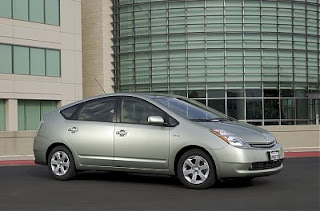Dealers Still Advertising Higher 2007 Fuel Economy Ratings
By Chris Haak
09.20.2007
 A breathless, critical report has been issued by CNW Marketing research stating that Toyota dealers are still claiming that the Prius can achieve 60 miles per gallon.
A breathless, critical report has been issued by CNW Marketing research stating that Toyota dealers are still claiming that the Prius can achieve 60 miles per gallon.
It has been reasonably well known in the automotive world for years that EPA fuel economy ratings were generally higher than what people could expect to see “in the real world.” Sure, it’s theoretically possible to drive like a stereotypical septuagenarian and achieve those window sticker numbers, but more likely than not, we’re accelerating more quickly, driving faster, and using accessories such as air conditioning and power steering that also require fuel to run. With gas prices near historic highs, consumers are more concerned about fuel economy than they have been in years, and were getting irritated when their own gas mileage didn’t match the numbers on the window sticker, in spite of the famous disclaimer, “your actual mileage may vary.” In response to this, the EPA has implemented a revised calculation to establish fuel economy for the window sticker for all 2008 and later models to better reflect “real world” experiences. The calculations are complex, but the end result is that most vehicles will see a 2-4 mile per gallon decrease in both city and highway fuel economy. The exception to that is hybrids, which took a disproportionate beating in their ratings. The Toyota Prius, previously rated at 60 miles per gallon in the city and 51 miles per gallon on the highway, dropped to 48 miles per gallon in the city and 45 miles per gallon on the highway. My own theory on the reason for the larger drop is not that Toyota was cheating, but that the Prius’ driving characteristics were very well suited to the conditions of the old test methodology (truth be told, I also am skeptical of the 21 miles per gallon highway rating of GM’s Tahoe full size SUV, thanks to its active fuel management that shuts down four of its eight cylinders, but in reality, rarely has the chance to do so).
The point is, although there really are people who achieved 60 miles per gallon in the Prius, though you have to “know” how to drive a hybrid like the Prius to maximize its fuel efficiency. (From what I have heard, it’s not the same thing as driving a conventional car for maximum economy). Most people achieve mileage in the mid-40s in the Prius, which is exactly what the EPA now says it should do.
Details left out of the report, however are:
- Do dealers of other brands also talk about fuel economy in terms of 2007 numbers?
- Are the Toyota dealers in question referring to 2008 Priuses or leftover 2007 models?
- Is doing this illegal, or even unethical?
- Who paid for this research?
Let’s dive into the implications of each of these.
I don’t know about other brands’ dealers, but I can say for sure that if you go today to http://www.gm.com/shop and click on “30+ MPG highway,” the only vehicles that come up in the search are 2007 models. Some of the models listed (Impala, Grand Prix, etc.) will not be over 30 miles per gallon in 2008, but GM is still advertising those models as being over 30 miles per gallon.
As far as whether the Priuses are 2007 or 2008 models (which would each have different economy figures on their window stickers), it’s impossible to tell (and I doubt that CNW knows), but wouldn’t the natural tendency of a salesperson be to cite the highest fuel economy figure he or she can for a given model? If the window sticker says 60/55 for a car they’re selling, then they should feel free to show that to a customer. If the customer asks about real world economy, I’d hope that they’d either be more realistic about it or tell them to check a neutral website like http://www.fueleconomy.gov/.
If the dealers are representing that 2008 models get 60 miles per gallon in the city, then I think they are being unethical and misrepresenting the car’s likely fuel economy. Actually, a better solution would have been for ALL new car window stickers on sale after a certain date (say, October 1, 2007) to show the new ratings, regardless of the model year. That way, it wouldn’t look like an old model was getting better fuel economy than a new one, when in fact they’re likely to be mechanically identical. Really, is it that expensive or difficult to reprint the window sticker for a new vehicle, in the interest of full disclosure and minimizing consumer confusion and angst? After all, the Fueleconomy.gov website has converted all past fuel economy ratings to the current 2008 equivalents to enable more fair comparisons between models and especially between different model years.
CNW’s website does not list this report, only its infamous “Dust to Dust” report that grossly exaggerated the energy costs of a Prius versus a Hummer (see excellent rebuttals of the Dust to Dust report on TrueDelta.com here and here). However, the company states that it performs syndicated studies that “protect you from seeing information that is skewed toward a particular point of view or company or product.” Yet, they seem to have a serious anti-Prius agenda after the Dust to Dust report and now this. Though it’s possible that an anti-Toyota client underwrote this latest research project, it is possible that the company undertook it on its own for publicity reasons.
COPYRIGHT Full Metal Autos – All Rights Reserved




